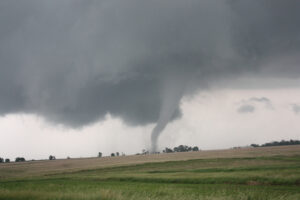
An Illinois tornado in 2010. Photo by Jarrod Cook, National Weather Service
We have lived on the Gulf and watched hurricanes organize off the swell of West Africa, grind their way across the expanse of the sea, thread their way through and over the islands, and turn north on the current to hit our coast.
We have lived on the Atlantic and experienced small hurricanes that damaged badly, and storms the size of Florida that sat and spun offshore before sliding up and away without major problems.
We have stocked up, boarded up, hunkered down, evacuated, waited through the night, returned home, and hoped for the best many days in a row. With the advent of satellite imagery and predictive modeling, this has often been a long, slow process.
But my family is Midwestern, so we have also spent much time, in short intervals, huddled in basements and bathrooms, sheltering from tornadoes. There is little to do to prepare and little warning. We were back at it last night, as a line of storms advanced through the midsouth and passed through the St. Louis area. Within five minutes, our phones popped off with public-safety warnings, the city sirens wailed, and my niece texted to say we had three minutes to get to cover. One of my sons, two aging cats, and I sheltered in a half-bath together.
The physical toll of hurricanes is terrible: sustained-wind damage and flooding from rain and sea cost billions. Hurricanes are more likely to ruin entire power grids, water supplies, sewer systems, and communications infrastructure. They kill and injure more people than tornadoes, and the poor bear the brunt.
Yet for me there is a special fear in tornadoes (which can of course spawn during hurricanes too). The sky in the Midwest often turns green, and clouds pile up in grotesque ways that do not happen in other storms. Tornadoes wobble across the countryside like a mean barroom drunk, as if to say, You think that you, with your mostly-tamed rivers and flat fields of corn, are far from the dangers of the open sea? I’ll show you.
Experiencing a hurricane is like enduring an awe-ful (in the old meaning) force of nature. A tornado is like a terrible accident or wrathful visitation, and I wonder about the overlay of the tornado- and Bible-belts. I do not know if seeing them, or having them hidden in the dark and from radar, is worse. As a teen, I was working at a Hardee’s when the city next to ours was partly destroyed by a tornado, and a schoolmate was killed. We took food and beverages to the National Guard in the first hours after it happened, and I will never forget the sight.
For us, last night, the worst of the threat was over in 30 minutes. But more than 30 tornadoes touched down, in five states, and there is the possibility that dozens died. Writer Bobbie Ann Mason’s hometown of Mayfield, Kentucky, was damaged badly. An Amazon warehouse in Illinois collapsed. This is still unusual weather for December in the Midwest, but the storms’ severity and frequency seem to be increasing, and of course population and development have grown, opening the likelihood for greater destruction. It is the warmest December on record in many states, and it is impossible to know what will come of it.
